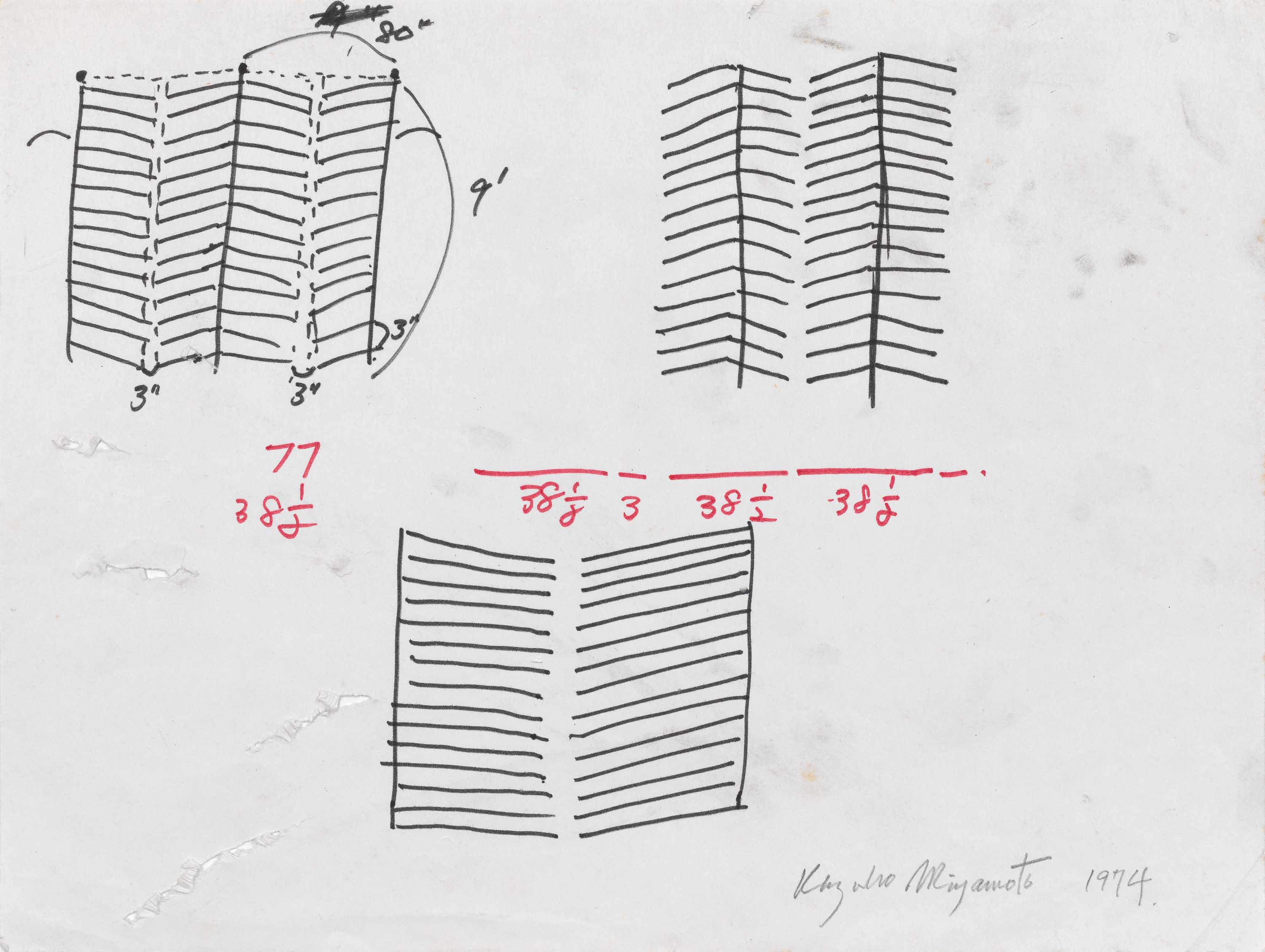String construction: dimensions variable
Plan: 21.6 × 27.9 cm, framed 29 × 36 × 2.5 cm
Courtesy of the artist and Take Ninagawa, Tokyo
Miyamoto Kazuko (b. 1942) studied at Tokyo’s Gendai Bijutsu Kenkyujo (Contemporary Art Research Studio) and emigrated to the United States in 1964 as she wanted to continue her art studies at New York City’s Art Student League. In 1968 she met artist Sol LeWitt and became his personal assistant, working on the production of his open cube sculptures and early wall drawings, while continuing her painting practice. As a very independent person, feminist and early member of A.I.R., the first all-female collective in New York, it is not surprising that she incorporated her own subtle changes to principles of contemporary art. As she moved away from the expressionist style from her student years towards minimalism and the abstract, she gradually incorporated process and culture in her sculptures, photographs (starting in 1980s) and movement in her dancing / performance and videos.
Miyamoto’s early large-scale paintings, often using geometrical language and grids, included personal markings, traces or smudges. This was her initial reaction to the strong and rigorous works of her male colleagues. Her practice quickly evolved to sculpture and drawings. Modular sculptures made with ropes, birch branches and other natural, readily available material, in geometrical shapes, led to experimenting with string interventions. Radical installations and included a two-dimensional Piece for the Wall in the Employee’s Cafeteria, MoMA, Untitled, 1973 (recreated for the 2023 exhibition at Madre (museo d’arte per le arti contemporanee), Naples, IT). As she shifted to these works starting in 1972, using industrial string or twine and nails, the floor, base or wall where they were installed were integral to the works. The works progressed very quickly from two to three-dimensions. The spatial illusion, shadows, lightness and luminosity as well as ephemeral qualities evolved. Fan-shapes or nets with cross strings, using her repetitive yet rhythmic motion and composition allowed for a very varied body of work. Many were conceived for specific spaces and exhibitions.
The color, thickness, twist and type of string, density or looseness varied continuously and added to the atmosphere, translucency of the mostly monochrome work. Thread texture and density make the constructions visually tactile and add additional sensory qualities, vibrations and forms. A sensory dialogue evolves between architecture and our bodies, static and fluidity, immobility and motion, our senses and abilities to perceive space. The preciseness of the minimalist language she embraced since moving to New York and simple tools invite us to examine our environment, depth, light and movement. Silence and gentleness seem to exude from her installations.
Miyamoto was often photographed with her work or that of life-long friend Sol LeWitt. She documented the vibrant music, art and dance scene of the Lower East Side in photographs. Videos of dance performances document her capabilities, learned as a child. She sewed and painted on kimonos and used these as well as umbrellas and artworks in her videos. From the 1980s onwards she created works with natural materials, paper and rope for outdoor parks, including for Art Across the Park, 1980 conceived by David Hammons for Central Park.
Untitled, 1974, dimensions variable, will be created in Basel according to her instructions.
The recent exhibition curated by Eva Fabris for Madre, will be open at the Belvedere, in September 2024.
Her works are part of the following important collections of the Art Gallery of New South Wales, Sydney, AU; Neue Galerie der Stadt, Linz; Lentos Art Museum, Linz, AT; Daimler Art Collection, Berlin; Daimler Contemporary, Berlin, DE; National Museum of Modern Art, Tokyo (MOMAT); National Museum of Modern Art, Kyoto, JP; The Metropolitan Museum of Art, New York; Museum of Modern Art, New York, New York; Princeton University Art Museum, Princeton, NJ; Smithsonian American Art Museum, Washington DC; Yale University Art Gallery, New Haven, CT; the LeWitt Collection, Chester, CT, US. Miyamoto has been the recipient of the 2003 Federico II Premio Internazionale di Pittura, Italy, the Francis J. Greenburger Foundation Award in 2003, and the National Endowment for the Arts, CAPS in 1979 & 1980. The artist lives and works in New York.
Anne Mosseri-Marlio

